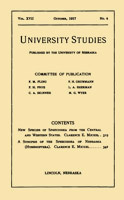University Studies of the University of Nebraska
Date of this Version
1926
Citation
UNIVERSITY STUDIES VoL. XXVI JANUARY-APRIL 1926 Nos. 1-2
Abstract
This paper is a study of the distribution and structure of the forests of extreme eastern Nebraska. The Missouri river, which forms the eastern boundary of the state, has so greatly modified the climate, that along its course an arm of the deciduous forest extends far into the grassland. Most of the trees and shrubs composing this forest are at the extreme western limit of their range. The range, grouping, and behavior of the several dominants and subdominants, under the environmental conditions imposed upon them, and the transition of forest to grassland are the subjects of this investigation. This region has been of interest to botanists since the time of the earliest explorations of the nineteenth century. The explorers (Lewis and Clark, 1803-1806; Nuttall and Bradbury, 1808; the Nicollet expedition, 1843; Warren, 1857) usually confined their activities to the woodlands along the natural highways, the streams; excursions into the prairie beyond being infrequent. Systematic investigation of the flora of Nebraska was begun in 1884 by Bessey. This resulted in the publication of numerous preliminary papers. Of these there may be mentioned the studies of the distribution of certain woody species (1887) and notes on the age and circumference of different trees planted in the prairie. A final list of the forest trees of Nebraska based on herbarium specimens was published in 1898. Bates (1894) in his notes on trees and shrubs of northern Nebraska discussed their distribution, and Pool (1919) in his handbook of Nebraska trees also gives their distribution in the state. Pound and Clements (1900) divided the state into regions based upon the natural vegetation. The woodlands were subdivided into " types." The formulation of the developmental system of classification of plant communities and an increased knowledge of plant succession (Clements, 1916), together with the development of modern methods of quantitative ecology, make possible a thorough and exact study of the environment and the distribution of forest communities.

